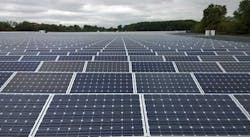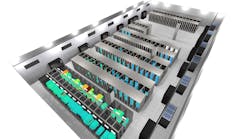50 Shades of Green for Data Centers
Welcome to the premiere edition of “Voices of the Industry”, a column for thought leaders in the data center industry to share their insights. This week’s column is from Chris Crosby, CEO of Compass Datacenters.
CHRIS CROSBY
CEO, Compass Datacenters
Webster’s defines irony as the “incongruity between what might be expected to happen and what actually happens.” Alanis Morrisette says, “It’s like rain on your wedding day,” and, as we recently saw, for the guys and gals at Apple, it’s flaming solar panels on the rooftop of your new data center. While this is certainly a setback for in the company’s everything-is-green strategy, they continue to boast of their corporate commitment to saving the planet.
Unfortunately, this rooftop barbeque incident has caused some people to look at the progenitors of the iPod, and many of their contemporaries, methods of maintaining the green bona fides. In other words, just like you would find in a 64 pack of crayolas, there are many shades of green.
Let’s begin our discussion by stating the obvious: there is nothing that is green enough unless you line the pockets of the funding source properly enough. While I realize this pronouncement may make some of you out there weak in the knees, if we adhere to the most stringent enviro-friendly requirements a truly green facility would consist of a data center situated next door to a solar field the size of a small city, paired with a wind farm large enough to make a sizeable dent in the area’s aviary population with a back-up power system supplied by the local municipality’s sewage treatment plant all the while using waste heat to warm an incubation farm of green sea turtle eggs. I think we can all agree that despite everyone’s best efforts, nobody has reached this level of Greenpeace nirvana.
Outcomes vs. Motives
I was recently at a session with one of these friendly, save-the-planet guys from National Resources Defense Council. His opening point was that data centers need to reduce the power consumption from 4 percent of US electricity to 1 percent. I asked: “What if we took it from 4 percent to 10 percent of the total consumption, but total consumption decreased by 5 percent?” Of course, the amount of total savings that IT and technology has done for the world never gets any credit in the discussion at all. Therefore, his response was that we would still need to reduce. My follow up question was to ask him for any single industry that was doing “good” as far as they wanted to see things. He couldn’t name one. No bias there. We are all evil.
I like to think of the world of business of falling into three camps: crony capitalists, good capitalists and bad capitalists. Crony capitalists use government and policy to run their business. It’s horrible stuff and a blog topic for another day (by the way, the extreme right and the extreme left have the worst crony capitalists). Good capitalists invest in people and technology to get an outsized return versus their competition. Name a hugely successful company with a good culture, and I guarantee you that there are good capitalists. Bad capitalists pursue selfish actions independent of the impact on others. Gordon Gecko is a superhero for bad capitalists. I believe that the NRDC guy thinks that anyone running a data center company falls into this category.
Here’s the rub: the data center infrastructure industry bad capitalists still invest for efficiency because it’s a selfish behavior – they make more money by doing so!
Since the purest shade of green is presently unobtainable, the whole green movement is based on a company’s quest to reach a level on the color spectrum that symbolizes to everyone that “we’re trying really hard.” Certainly no one can argue that the folks at Apple are at least a “Forest Green” since nothing says commitment like a solar panel conflagration. They’ve also hired the former Director of the EPA as head of “Environmental Initiatives” and pledged to run 100 percent of its office, data centers and retail stores with renewable energy. And herein lies the rub, as they say. You probably haven’t seen any windmills outside of the mega-mall that houses your local Apple store. As a result, you are a witness to the fact that alternative energy sources just aren’t efficient or effective enough (in terms of power generation and cost) to replace the use of – wait for it – fossil fuels.
Since the world isn’t going to be shifting away from the by-products of the flora and fauna of the Pleistocene Era any time soon, a number of data center builders and providers have decided to shoot for the “Sea Green” level of planet friendliness by purchasing “Carbon offsets.” For those of you unfamiliar with the term, the funds from the purchase of an offset are used to support projects that reduce the emission of greenhouse gas emissions elsewhere. This means that that the greenhouse gas emissions from your data center in New Jersey are “offset” by a wind farm in Denmark, for example – “This turbine sponsored by ‘X’.”
Chris Crosby is the CEO of Compass Datacenters.






